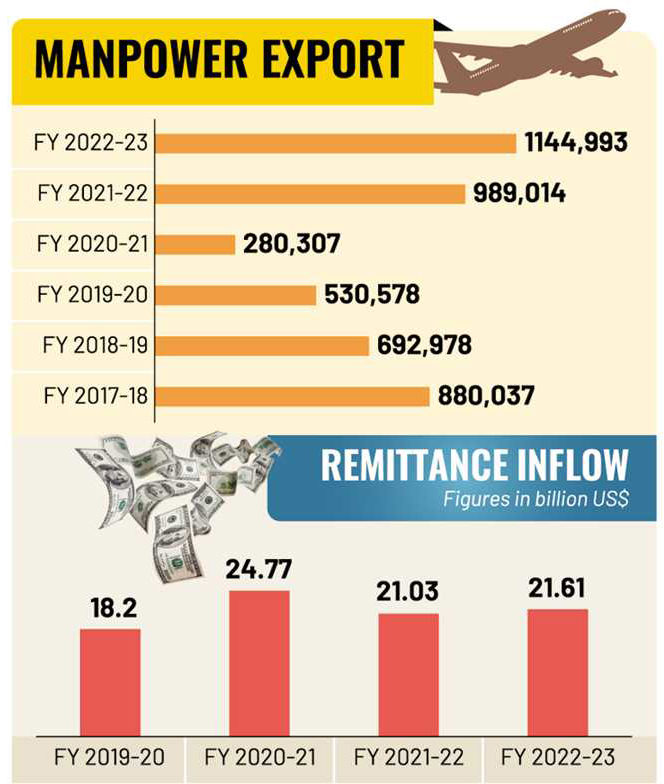The country's overseas employment hit a six-year high of more than 1.1 million in the just-passed financial year 2022-23 as the traditional Middle East markets hired an increased number of workers from Bangladesh.
But despite the rise in employment, inward remittance has not increased much as most of the labour migration from Bangladesh was less skilled.
Bangladesh sent 1,144,993 workers in the outgoing fiscal year (FY) while the country sent 989,014 workers in the FY 2021-22, 280,307 in the FY 2020-21, 530, 578 in the FY 2019-20, 692,978 in the FY 2018-19, and 880,037 in the FY 2017-18, according to the statistics released by the Bureau of Manpower, Employment and Training (BMET).
The majority of the workers went to the traditional job markets like Saudi Arabia, Oman, United Arab Emirates and Malaysia in the FY 2022-23.
Sector insiders said manpower recruiters usually bring the demand for less skilled workers from different countries. That is why the number of less skilled workers is still much higher than the number of skilled ones.

Besides, the country still lags behind in creating skilled manpower for the overseas job market, they opined.
On the other hand, many workers are returning home every year finding no work or losing jobs. Some of them are also victims of human trafficking.
According to airport immigration data, every year an average of 50,000 Bangladeshi workers return home.
However, the number was 100,000 in 2022, of which 70,000 were from Saudi Arabia.
Dr Khondaker Golam Moazzem, research director at the Centre for Policy Dialogue (CPD), said since there is a demand for unskilled workers, Bangladesh also needs this market.
But in the countries where skilled workers are in demand, manpower recruiters need to develop network as other labour-sending countries are doing.
He said Bangladesh has been branded in the international market as an unskilled workers-sending country. The country has to gradually come out of this image.
The less-skilled labour migration from Bangladesh increased from 71.59 per cent in 2010 to 74 per cent in 2022.
However, the BMET data showed that the rate of skilled workers increased to a record 43.55 per cent in 2019 -soon afterwards, the number started declining and reached a record low of 22.22 per cent in 2022.
Per capita average monthly income of Filipino migrants was $564.1, Chinese migrants $532.71, Indian ones $395.71, Pakistani ones $275.74 and Bangladeshi ones $203.33, the International Organization for Migration (IOM)'s migration report-2019 revealed.
Bangladesh Bank data showed Bangladeshi workers remitted US$21.61 billion home in the FY 2022-23, $21.03 billion in 2021-22, $24.77 billion in 2020-21, and $ 18.20 billion in the FY 2019-20.
Shariful Islam Hasan, associate director of the Migration Programme and Youth Platform at BRAC, said if unskilled workers are sent, the migration cost will be higher and the workers will also get less salary.
As a result, despite sending more workers, the remittance flow is not increasing.
Considering these issues, he also said, workers should stop going abroad without acquiring skills.
He suggested including technical training in the education system. Without introducing compulsory technical education at the school level it will not be useful to send increased number of workers abroad.
When contacted, Ahmed Munirus Saleheen, senior secretary at the Ministry of Expatriates' Welfare and Overseas Employment, said they are emphasising sending skilled workers abroad.
But there are still limitations in sending skilled workers from Bangladesh.
In most cases, unskilled workers are in demand from employers. Manpower recruiters need to bring in the demand for skilled workers.
"From our side also we are trying how to solve the problems," he added.
arafataradhaka@gmail.com